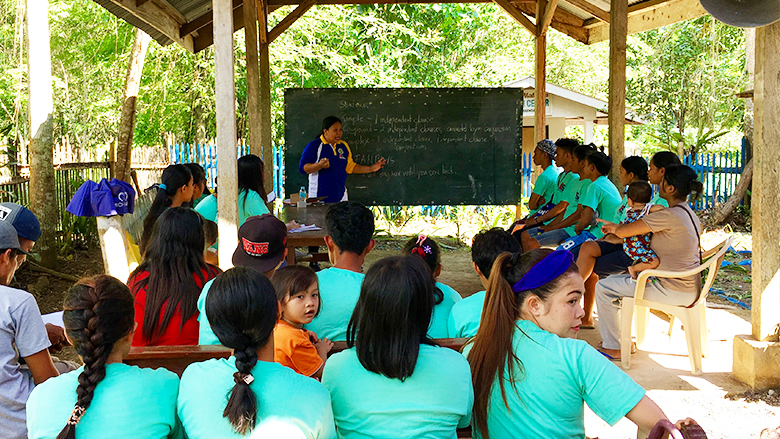The report focuses on the context for the Alternative Learning System (ALS) program in the newly established Bangsamoro Autonomous Region in Muslim Mindanao (BARMM), where people have experienced several decades of armed conflict and civil unrest. The region’s social services such as education had been affected, which has resulted in a high number of youth and adults who have limited education, literacy, and skills.
Complementary to the efforts in providing quality education for all Filipino children, the Department of Education has been operating the ALS program throughout the Philippines including BARMM. ALS has brought second-chance learning for out-of-school youth and adults for the past few decades throughout the country. The ALS program consists of:
- Basic Literacy Program (BLP) that aims to eradicate illiteracy; and
- Accreditation and Equivalency (A&E) Program that target people who are independent learners but did not complete the formal elementary or junior high school levels. Official certificates equivalent to formal school diplomas can be earned if learners could pass the A&E exams.
Since 2013, the World Bank has partnered with the Department of Education to assess the delivery of the ALS program aiming to improve its quality. The previous evaluations of ALS to date have not covered the BARMM area. This new report fills that gap and aims to provide the new BARMM government with essential evidence to improve the program delivery.
Key Findings
Despite remarkable progress in the country’s basic education system reforms over the last decade, BARMM has been facing persistent and serious challenges in formal education and ALS.
- While almost all Filipino children start elementary school at age six, only 70% start school on time in BARMM. Nationwide, 80% of students enroll in junior high school on time, but only 30% of students enter junior high school on time in the region.
- Out-of-school youth and adults have thus accumulated over the generations in BARMM – almost 45% of 16-30 years old are out-of-school in BARMM, double the national average.
- Only 5% of out-of-school youth and adults participated in ALS in BARMM, compared to the national average of 13%. 35% of the ALS enrollees graduated, which was about half of the national average.
- Out of 840,000 enrolled in the Alternative Learning System nationally in 2019, 25,000 are from BARMM.
- Despite the improvement of the Accreditation and Equivalency exam passing rate from 2016 to 2018, the region is 20 percentage points behind the national average.
- ALS learners in BARMM show lower literacy skills, as well as socio-emotional skills on average as compared with the national average score of out-of-school adults of the same age cohort.
- Basic supplies, learning modules, operational budgets, and learning facilities for ALS are lacking in quantity and quality nationwide, but the level of deficiencies is more serious and urgent in BARMM.
- ALS teachers in BARMM severely lack in number and specialization. They have also had limited training. In BARMM, the ratio of out-of-school adults to a facilitator is 1,800 to 1, by far the highest of all regions, and 10% of existing teachers will retire in the next five years in the region.
- ALS learners rarely receive support to make good career choices after graduating from ALS. Also, less than half of the ALS facilitators provided livelihood skills training for their own learners in 2018 in BARMM.
Recommendations
Improving the quality of basic education will help eventually reduce the large number of out-of-school youth and adults. To improve the quality and effectiveness of the ALS system as it operates in BARMM, significant changes need to be made. The report suggests the following recommendations:
- Level up the overall program delivery. The BARMM Strategic Roadmap for Alternative Learning Modalities, which provides priority actions and activities with specific timelines, could be an important guide to improve the ALS program delivery.
- Boost capacity building programs for ALS teachers. Both existing and incoming ALS teachers need better quality training, particularly training focused on academic approaches in ALS, as well as the new K-12 Basic Education ALS curriculum in the short term. In the medium term, localized peer-learning programs could be introduced for ALS teachers to promote their continuous professional development.
- Improve approaches to out-of-school youth and adults outreach. Targeted approaches through using more accurate data could be introduced for community mapping and advocacy to effectively reach out to them.
- Intensify response to special challenges. Streamline practices in the field and on-site supervision. In conducting regular program audits, consider engaging the third parties, such as civil society groups and local communities, as well as use of technology.
- Continued strong collaboration between the Department of Education and the new BARMM Ministry of Education on ALS will remain foremost important. The national level has a significant role to play not just in allocating resources, setting the strategic direction and policy, and refining system components in pursuit of the Enhanced ALS Version 2.0, as well as providing necessary technical assistance for BARMM.
